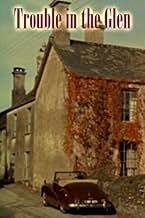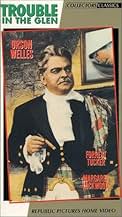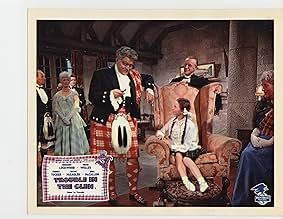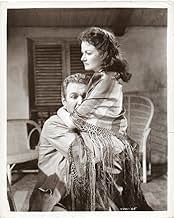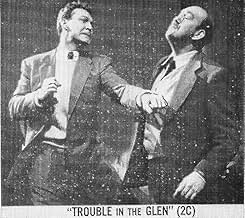Ajouter une intrigue dans votre langueMajor Jim "Lance" Lansing, an American ex-pilot of the U.S. Air Corps, returns to Scotland after the war and finds much trouble in the glen where he settles because of the high-handed activi... Tout lireMajor Jim "Lance" Lansing, an American ex-pilot of the U.S. Air Corps, returns to Scotland after the war and finds much trouble in the glen where he settles because of the high-handed activities of the local laird, Sandy Mengues, a wealthy South American who, with his daughter Ma... Tout lireMajor Jim "Lance" Lansing, an American ex-pilot of the U.S. Air Corps, returns to Scotland after the war and finds much trouble in the glen where he settles because of the high-handed activities of the local laird, Sandy Mengues, a wealthy South American who, with his daughter Marissa, has returned to the land of his forefathers. Led by Lansing, the people eventually ... Tout lire
- Director
- Writers
- Stars
- Dandy Dinmont
- (as Ann Gudrun)
- Alsuin
- (as Margaret McCourt)
- Bishop's Wife
- (uncredited)
- Old Tinker Woman
- (uncredited)
- Townsman
- (uncredited)
- Bishop
- (uncredited)
Avis en vedette
Interesting -- umm, 7 /10, agreed?, agreed!
Forgettable film; there's really not much going on here. Fans of THE QUIET MAN may be interested in this lesser work by the same author, but if you're looking for lots of comedy OR action, you'll be disappointed. To see Tucker and Lockwood in a more interesting film, check out LAUGHING ANNE (1954).
Everyone in the glen tries to persuade Mengues to bring piece to their homes, only to have Lansing and Parlan (Victor McLaglen), the Mengues foreman, get in a fight together.
This was listed in my UK TV schedule as a good film and they have it a three-star rating. They made it sound like it was a film about Orson Welles visiting Scotland after the war, which is far from the actual plot.
Welles really chews up the scenery - in a bad way. He's funny but also quite annoying and seems out of place. Lockwood is given little to do but be pretty. Tucker is so-so.
I was disappointed because I was expecting something entertaining and "classy," whereas instead I got a boring, dull and sappy "nice" movie without any real positive traits.
It's not terrible, it's just not very good.
Lensed in sludgy brown Trucolor, "Trouble in the Glen" plays like an Ealing comedy sans asperity, fading quickly into the Celtic twilight from which Brigadoon rises once a century. Orson Welles is a returning laird whose years in South America presumably explain his swarthy skin tones if not his blue-grey bouffant wig. Welles was already a podgy Hollywood outcast wandering the European co-production badlands, scrounging, spending and sometimes shooting: he was between "Othello" and "Mr Arkadin" at this juncture. He relies on his magnificent organ voice and eyes that gleam in the gloom (as in "Jane Eyre") to sustain his turn as a tyrant, at odds both with his glenfolk tenantry and with a roving gang of tinkers. The head "tink" is the terminally fuddled Victor McLaglen, another Ford veteran.
Stuffing casts with faded US talent to win a Stateside circuit release was standard operating procedure for the struggling Britflick biz of the early 1950s. Besides Citizen Kane and Sgt Quincannon, "Trouble in the Glen" toplines the colourless Forrest Tucker. Like John Wayne in "The Quiet Man", Nugent makes him a Yank on a sentimental journey. Like Wayne, he banters or scraps with the locals and tames a spirited filly: Maggie Lockwood, the laird's daughter, in reality four years older than Orson! Her cut-glass accent matches neither Welles's nor the area's Scotch English. There is also a winsome, bedridden little girl for Tucker to set on her feet.
The subplot concerns unjust suspicions that the tinkers stole a deer. Has there ever been a movie in which gypsies or traveling people actually did the crimes of which they are accused?
John Ford wanted to do the film for years and went with Republic Pictures because he didn't have to pay for John Wayne's services. Still the penny pinching founder and head of Republic, Herbert J. Yates drove Ford crazy with his budget cutting here and there. It was a miracle the film was made at all and on location.
So when The Quiet Man becomes a big artistic and commercial triumph, now Yates must be thinking himself a genius so why not assemble the same team, but without that troublesome John Ford. Go to Herbert Wilcox to produce and direct and we can even get Orson Welles who'll do just about anything to finance his projects. Since we'd now have to pay John Wayne a big salary since he's no longer under contract to Columbia, we'll get a second line actor like Forrest Tucker for his role.
I can see all the wheels turning in Mr. Yates's mind as he probably plunged enthusiastically into Trouble in the Glen which can be described as a Scottish version of The Quiet Man. The problem is that it really did need the touch of John Ford to make it a great film.
As it is it's not a bad film, Orson Welles and Victor McLaglen are at their scene stealing best. Forrest Tucker and Margaret Lockwood who is Welles's daughter are an attractive pair of romantic leads. The film is about an heir to a Scottish estate returning from South America and taking over the family place, but then getting into a quarrel with the locals and cutting them off from the use of a road running through his property. Forrest Tucker is like John Wayne, the stranger from America who has ties to the place also that we don't really learn about until almost the end of the film.
Trouble in the Glen has the same kind of beautiful location cinematography that The Quiet Man has. But it really needed someone like John Ford at the helm.
Le saviez-vous
- AnecdotesServing as an uncredited assisting cinematographer on this film was Gilbert Taylor, 23 years later the director of photography for La guerre des étoiles (1977). Also, the featured cast includes both Alex McCrindle and Eddie Byrne who in the iconic blockbuster would respectively play General Dodonna and General Willard, two rebel leaders on the Yavin moon base during the battle against the first Death Star. Dodonna is the one who greets Princess Leia upon her arrival, and Willard is the one detailing the attack to the fighter pilots, ending his talk with the first time anyone in the series ever said "May the Force be with you."
- ConnexionsFeatured in Scotland on Screen (2009)
Meilleurs choix
Détails
- Date de sortie
- Pays d’origine
- Langue
- Aussi connu sous le nom de
- Envis som synden
- Lieux de tournage
- société de production
- Consultez plus de crédits d'entreprise sur IMDbPro
- Durée1 heure 31 minutes

